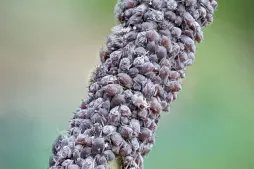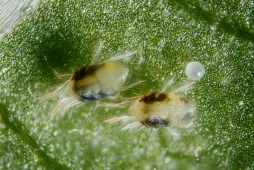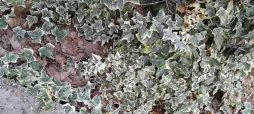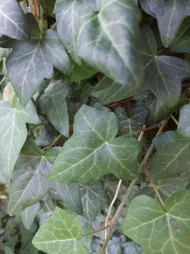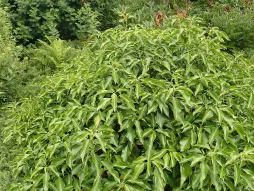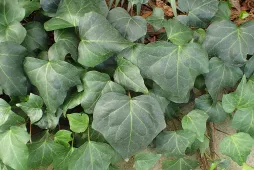Hedera helix, common ivy
Better known as ivy, Hedera helix is native to Europe. A member of the Araliaceae family, this plant is a must-have on the Old Continent. It covers the facades of houses and gives fences, hedges and other walls that you want to hide, the look of an English cottage.
How to recognize common ivy, Hedera helix?
Common ivy is a perennial plant. This shrubby creeper usually grows to a height of ten meters in all directions. But if left untrimmed, it can live for centuries, reaching 100 meters in length and 30 meters in height. Growth habit depends on variety and growing conditions. Hedera helix can be climbing, drooping or bushy.
Woody stems have brown bark. They are covered with gray, star-shaped hairs. Climbing branches are the hairiest. They have spikes at the internodes. These adventitious roots enable the plant to cling to its support.
Alternate leaves are tough. Several types of leaf blade can be found on the same ivy stump. The youngest are star-shaped. Older ones are webbed, with three or five lobes. On some branches, those that will host the flowering, the leaves are oval with a pointed apex.
The color of the foliage depends on the type of leaf blade and the variety. In the botanical variety, Hedera helix, juvenile leaves are bright green, while older leaves are dark green. Cultivars with yellow or white variegated leaves, such as hedera 'Eva, are also available.
Common ivy flowers in September. Corymbs of greenish or yellow flowers bloom in clusters at the ends of the stems.
Fruits appear in winter. The bluish-black berries measure no more than a centimetre in diameter. They contain five to six seeds.
While the fruits are a delight for birds, they are toxic to humans and other mammals. The berries and leaves can cause respiratory and digestive problems when ingested, even in minute quantities.
Our maintenance tips
Hedera helix are sometimes sold as houseplants. But they are in fact hardy and resistant outdoor plants. So hardy, in fact, that they can become invasive! Think carefully before planting your specimen. Once it's in the ground, you won't be able to move it.
Watering
Water when the substrate is dry on the surface, for about three centimeters. Use non-calcareous water, such as rainwater, filtered water or mineral water.
Don 't let water stagnate in the planter or saucer, as it may rot the roots.
Repotting
Choose a pot with holes larger than the previous one. Two centimetres more in diameter and depth will suffice. Line the bottom with clay balls or gravel to optimize drainage.
Pour in a layer of universal potting soil. Plant your Common ivy and add substrate.
Planning to climb your plant on a wall or pergola? The stems should find their way up on their own. But you can help them a little by arranging the branches on the support.
Fertilization
To promote the growth of your Hedera helix, apply fertilizer in spring and summer.
Addgreen plant fertilizer to watering water.
Place a little compost at the foot of your Common ivy to enrich the soil and accelerate growth.
Prune
Your Common ivy is a fast-growing plant. You need to prune it to control its spread and prevent it from invading you.
Arm yourself with a clean, sharp tool. Depending on the diameter of the stems, you may choose scissors or pruning shears.
Remove dead branches by cutting at their base.
Shorten branches that have become too long by cutting just above a node. This encourages branching and helps maintain a compact habit.
Plantation
When the risk of frost has passed, it's time to plant.
Soak the rootball in a bucket of water at room temperature. Meanwhile, dig a hole twice the size of the rootball.
Plant your Common ivy without burying the collar. Fill in with your garden soil and water.
The plant will naturally cling to its support. But you can encourage it to do so by arranging the branches against the wall or trellis you've planned.
Cutting
Cutting is carried out during the strong growth phase, generally in spring and early summer.
Using a clean, sharp tool such as scissors or pruning shears, remove a ten- to fifteen-centimeter stem. Cut between two nodes and remove the leaves, leaving only the top pair.
In a pierced pot, pour a layer of clay balls for drainage. Add potting soil for seedlings and planting.
Using a pencil, make a pilot hole and plant your cutting.
Water at room temperature to help the plant take root.
Diseases / Threats
Information
| Family | Araliaceae - Araliaceae |
| Type | Ivy - Hedera |
| Species | Common ivy - Hedera helix |
| Lifecycle | Perennial |
| Foliage | Evergreen |
| Exposures | |
| Substrats | |
| Planting methods |
Open ground In pots In tubs Planter |
| Categories | |
| Tags |
Beginner Invasive Increvable Rustic Toxic |
| Origins |
Northern Europe Eastern Europe Southern Europe Western Europe |
| Hardiness (USDA) | 6a |
| Leaf color |
|
| Flower colors |
|
| Fruit color |
|
Discover plants from the same family













